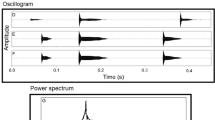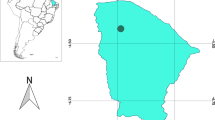Abstract
Empirical research on human and non-human primates suggests that communication sounds express the intensity of an emotional state of a signaller. In the present study, we have examined communication sounds during induced social interactions of a monogamous mammal, the tree shrew. To signal their unwillingness to mate, female tree shrews show defensive threat displays towards unfamiliar males paralleled by acoustically variable squeaks. We assumed that the distance between interacting partners as well as the behavior of the male towards the female indicates the intensity of perceived social threat and thereby the arousal state of a female. To explore this hypothesis we analyzed dynamic changes in communication sounds uttered during induced social interactions between a female and an unfamiliar male. Detailed videographic and sound analyzes revealed that the arousal state predicted variations in communication sound structure reliably. Both, a decrease of distance and a male approaching the female led to an increase in fundamental frequency and repetition rate of syllables. These findings support comparable results in human and non-human primates and suggest that common coding rules in communication sounds govern acoustic conflict regulation in mammals.



Similar content being viewed by others
Abbreviations
- AFRMB:
-
Analysis of female response to male behavior
- AFRMP:
-
Analysis of female response to male proximity
- F 0 :
-
Fundamental frequency
- IR:
-
Interquartile range
- ISI:
-
Intersyllable interval
- PF:
-
Peak frequency
References
Aureli F, Smucny D (2000) The role of emotion in conflict and conflict resolution. In: Aureli F, de Waal FBM (eds) Natural conflict resolution. University of California Press, Berkeley, pp 199–224
Bachorowski JA (1999) Vocal expression and perception of emotion. Curr Dir Psychol Sci 2:53–57
Bänziger T, Scherer KR (2005) The role of intonation in emotional expressions. Speech Commun 46:252–267
Binz H, Zimmermann E (1988) The vocal repertoire of adult tree shrews (Tupaia belangeri). Behaviour 109:142–162
Blumstein DT, Armitage KB (1997) Alarm calling in yellow-bellied marmots: I. The meaning of situationally variable alarm calls. Anim Behav 53:143–171
Bortz J (1993) Statistik für Sozialwissenschaftler. Springer, Berlin
Darwin C (1872) The expression of emotions in man and mammals. Murray, London
Ehret G (2006) Common rules of communication sound perception. In: Kanwal J, Ehret G (eds) Behaviour and neurodynamics for auditory communication. Cambridge University Press, Cambridge, pp 85–114
Emmons LH (2000) A field study of Bornean tree shrews. University of California Press, Berkeley, Los Angeles, London
Fichtel C, Hammerschmidt K, Jürgens J (2001) On the vocal expression of emotion. A multiparametric analysis of different states of aversion in the squirrel monkey. Behaviour 138:97–116
Fischer J, Hammerschmidt K, Todt D (1995) Factors affecting acoustic variation in Barbary-macaque (Macaca sylvanus) disturbance calls. Ethology 101:51–66
Fuchs E (1999) Tree shrews. In: Poole T (ed) UFAW Handbook on care and management of laboratory animals. Blackwell, Oxford, pp 235–245
Haccou P, Meelis E (1994) Statistical analysis of behavioural data. Oxford University Press, New York
Hauser MD, Marler P (1993) Food-associated calls in rhesus macaques (Macaca mulatta): I. Socioecological factors. Behav Ecol 4:194–205
Heffner HE, Ravizza RJ, Masterton B (1969) Hearing in primitive mammals: III Tree shrew (Tupaia glis). J Aud Res 9:12–18
Hertenstein B, Zimmermann E, Rahmann H (1987) Zur Reproduktion und ontogenetischen Entwicklung von Spitzhörnchen (Tupaia belangeri). Z Kölner Zoo 30:119–133
von Holst D (1986) Psychosocial stress and its pathophysiological effects in tree shrews (Tupaia belangeri). In: Schmidt TH, Dembroski TM, Blumchen G (eds) Biological and psychological factors in cardiovascular disease. Springer, Heidelberg, pp 476–489
Jürgens U (1979) Neural control of vocalizations in nonhuman primates. In: Steklis HD, Raleigh MJ (eds) Neurobiology of social communication in primates. Academic, New York, pp 11–44
Kalin NH, Shelton SE Snowdon CT (1992) Affiliative vocalizations in infant rhesus macaques, Macaca mulatta. J Comp Psychol 106:254–261
Kalin NH, Larson C, Shelton SE, Davidson RJ (1998) Asymmetric frontal brain activity, cortisol, and behavior associated with fearful temperament in rhesus monkeys. Behav Neurosci 112:286–292
LeDoux JE (2000) Emotion circuits in the brain. Ann Rev Neurosci 23:155–184
Lieberman P, Blumstein SE (1988) Speech physiology, speech perception, and acoustic phonetics (Cambridge studies in speech science and communication). Cambridge University Press, Cambridge
MacLarnon A, Hewitt G (2004) Increased breathing control: another factor in the evolution of human language. Evol Anthropol 13:181–197
Manser MB (2001) The acoustic structure of suricates’ alarm calls varies with predator type and the level of response urgency. Proc R Soc Lond B 268:2315–2324
McNaughton N, Corr PJ (2004) A two-dimensional neuropsychology of defense: fear/anxiety and defensive distance. Neurosci Biobehav R 28:286–305
Monticelli PF, Tokumaru RS, Ades C (2004) Isolation induced changes in guinea pig Cavia porcellus pup distress whistles. Ann Braz Acad Sci 76(2):368–372
Morton ES (1977) On the occurrence and significance of motivation-structural rules in some bird and mammal sounds. Am Nat 111:855–869
Rendall D (2003) Acoustic correlates of caller identity and affect intensity in the vowel-like grunt vocalizations of baboons. J Acoust Soc Am 113:3390–3402
Sargis EJ (2004) New views on tree shrews: the role of tupaiids in primate supraordinal relationships. Evol Anthropol 13:56–66
Scherer KL (1979) Nonlinguistic vocal indicators of emotion and psychopathology. In: Izard CE (ed) Emotions in personality and psychopathology. Plenum Press, New York, pp 495–529
Scheumann M, Deichsel G, Zimmermann E (2007) Context-specific calls signal infants’ needs in a strepsirrhine primate, the gray mouse lemur (Microcebus murinus). Dev Psychobiol (in press)
Soltis J, Leong K, Savage A (2005) African elephant vocal communication II: Rumble variation reflects the individual identity and emotional state of callers. Anim Behav 70:589–599
Tembrock G (1977) Tierstimmenforschung. Die neue Brehm-Bücherei, Lutherstadt
Zimmermann E (1993) Behavioral measurements of auditory thresholds in developing tree shrews (Tupaia belangeri). J Acoust Soc Am 94:3071–3075
Acknowledgments
This work was supported by the DFG Research Group 499. The experiments are licensed by the Bezirksregierung Hannover, Germany (reference number: 509.6-42502-03/660) and comply with the “Principles of animal care”, publication No. 86-23, revised 1985 of the National Institute of Health. We thank S. Schmidt for critical comments on an earlier version of this manuscript and M. Scheumann for help with acoustic analysis. We also thank B. Haßfurther for digitalising of video recordings, as well as R.W. Brüning for technical support and W. Mehl, H.-J. Sauer, and S. Kunath for animal care.
Author information
Authors and Affiliations
Corresponding author
Rights and permissions
About this article
Cite this article
Schehka, S., Esser, KH. & Zimmermann, E. Acoustical expression of arousal in conflict situations in tree shrews (Tupaia belangeri) . J Comp Physiol A 193, 845–852 (2007). https://doi.org/10.1007/s00359-007-0236-8
Received:
Revised:
Accepted:
Published:
Issue Date:
DOI: https://doi.org/10.1007/s00359-007-0236-8




